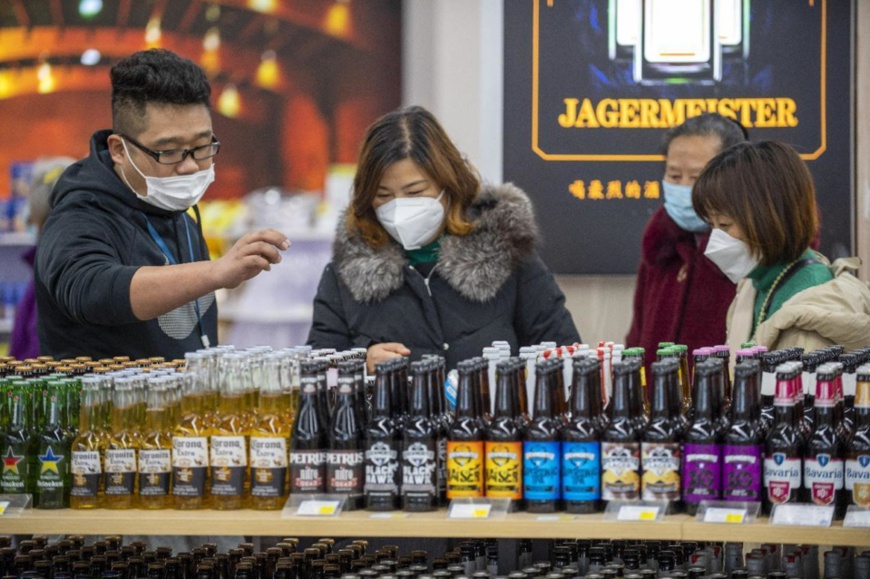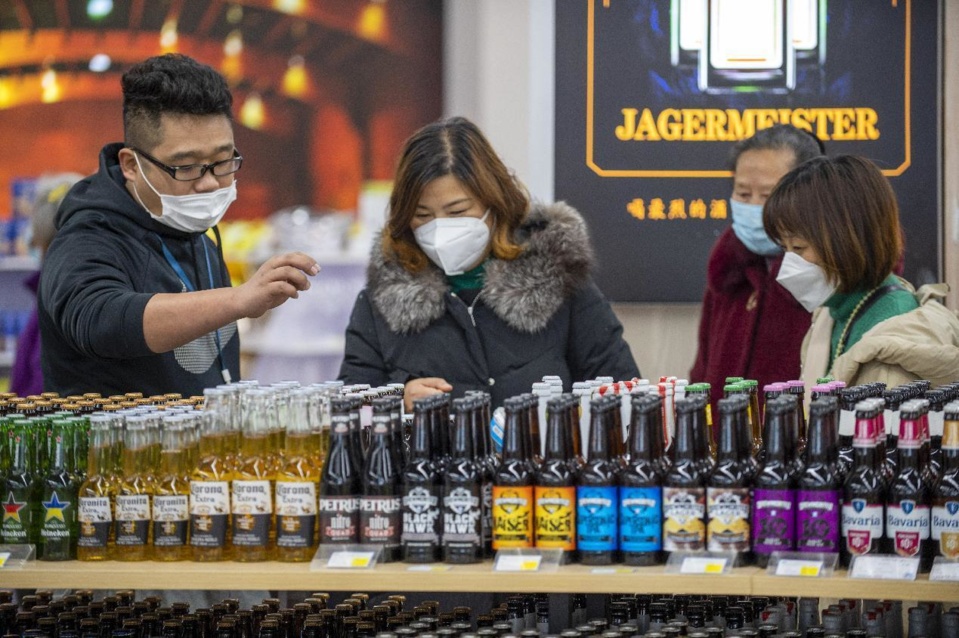By Wang Wenzheng

Consumers buy imported products at a shopping center in a comprehensive bonded area in Jinyi New Area, Jinhua, east China's Zhejiang province, Jan. 17, 2022. (Photo by Hu Xiaofei/People's Daily Online)
The Regional Comprehensive Economic Partnership (RCEP) has entered into force for more than six months. Constantly expanding its “circle of friends,” the regional free trade agreement has released huge dividends for enterprises and consumers from participating countries in the past half a year.
The coming into force of the RCEP has lowered market access, thus allowing more Chinese products to get into the international market.
“Our company has applied for nine RCEP Certificates of Origin for ceramic tiles exported to South Korea, which involve 2.58 million yuan ($384,988) of products. We are expected to enjoy a tariff reduction of over 100,00 yuan,” said Zhu Zhifang, a ceramic tile producer in south China’s Guangdong province.
Besides, more high-quality imports are entering the Chinese consumption market thanks to the RCEP, said an official from the Chinese Ministry of Commerce (MOFCOM).
“During the first half of this year, we saw more and more premium products from overseas and the price of some of them was going down,” said a citizen surnamed Chen from Beijing.
The RCEP lowers the cost of imported products by eliminating 90 percent of the tariffs on goods traded between its signatories. The high-level trade facilitation measures under the agreement also allows consumers to buy imported products at a fairer price and a faster speed.
The RCEP is the world's largest platform of institutional opening up. Its participating countries account for around 30 percent of the world's total population, economy and trade volume. As a free trade pact with enormous market potential, the RCEP is expanding win-win benefits for all countries related.
In the first quarter of this year, Thailand’s total trade volume under the RCEP exceeded 2.7 trillion Thai baht ($75.8 billion), up 23 percent year on year. In particular, the growth in the agricultural sector surged by 43 percent.
“Monthong durians have a huge market in China. They make up a majority of our products,” said a farmer running a durian farm in Chanthaburi province, Thailand. The woman told People’s Daily that she will breed better varieties to cater to the diversified demands of international consumers.
In the same period, Vietnam’s total trade volume with China, Japan, South Korea, and other ASEAN countries grew by 10 percent. Japan’s trade volume with other RCEP participating countries neared $200 billion, accounting for 47.6 percent of its total foreign trade.
Since the RCEP entered into force for South Korea on February 1 this year, the country’s export hit $63.48 billion in March, up 18.2 percent year on year. Since 1956, this was the greatest amount the country has ever seen.
According to estimation, the RCEP is expected to help its members increase export, stocks of outbound investment and GDP by 10.4 percent, 2.6 percent, and 1.8percent, respectively by 2025.
HSBC forecasted that the share of RCEP members will rise to over 50 percent of global output in 2030. A report by the United Nations Conference on Trade and Development said the RCEP has become a new focus of global trade for its size and vitality, which would significantly mitigate the negative impacts from COVID-19 on regional economy and restore confidence in global recovery.
“A number of promotional activities about the RCEP were held before the agreement went into force, which greatly helped us further expand the Japanese market,” said Li Hui, who’s in charge of customs affairs of a special material company in Zhuhai, south China's Guangdong province.
Over the past six months, local governments and departments across China have rolled out substantial measures for better releasing the dividends of the RCEP.
Earlier this year, the MOMCOM, together with other departments, issued a guideline on the high-quality implementation of the RCEP, guiding local governments, industries, and enterprises to better suit the opener environment and more fierce competition after the RCEP came into force.
In April, the MOFCOM held a thematic training event about the RCEP for major enterprises. The event introduced the RCEP, the rules of RCEP market access and origin, access commitments of RCEP service trade and investment market, as well as the challenges and opportunities facing Chinese industries.
China’s efforts to align the Chinese market with the RCEP and fulfill the country’s commitment to opening up mirror its resolution and sincerity to further expand opening up.
“China takes the RCEP as an important platform to deepen institutional opening up, and is ready to fulfill 701 binding obligations and 170 encouraging obligations under the agreement,” said Gu Xueming, president of the Chinese Academy of International Trade and Economic Cooperation.
“The country requests government departments and local governments to fulfill the RCEP at a high level, so as to nurture a sound environment for deepening reform in accordance with RCEP standards,” Gu added.
The coming into force of the RCEP has lowered market access, thus allowing more Chinese products to get into the international market.
“Our company has applied for nine RCEP Certificates of Origin for ceramic tiles exported to South Korea, which involve 2.58 million yuan ($384,988) of products. We are expected to enjoy a tariff reduction of over 100,00 yuan,” said Zhu Zhifang, a ceramic tile producer in south China’s Guangdong province.
Besides, more high-quality imports are entering the Chinese consumption market thanks to the RCEP, said an official from the Chinese Ministry of Commerce (MOFCOM).
“During the first half of this year, we saw more and more premium products from overseas and the price of some of them was going down,” said a citizen surnamed Chen from Beijing.
The RCEP lowers the cost of imported products by eliminating 90 percent of the tariffs on goods traded between its signatories. The high-level trade facilitation measures under the agreement also allows consumers to buy imported products at a fairer price and a faster speed.
The RCEP is the world's largest platform of institutional opening up. Its participating countries account for around 30 percent of the world's total population, economy and trade volume. As a free trade pact with enormous market potential, the RCEP is expanding win-win benefits for all countries related.
In the first quarter of this year, Thailand’s total trade volume under the RCEP exceeded 2.7 trillion Thai baht ($75.8 billion), up 23 percent year on year. In particular, the growth in the agricultural sector surged by 43 percent.
“Monthong durians have a huge market in China. They make up a majority of our products,” said a farmer running a durian farm in Chanthaburi province, Thailand. The woman told People’s Daily that she will breed better varieties to cater to the diversified demands of international consumers.
In the same period, Vietnam’s total trade volume with China, Japan, South Korea, and other ASEAN countries grew by 10 percent. Japan’s trade volume with other RCEP participating countries neared $200 billion, accounting for 47.6 percent of its total foreign trade.
Since the RCEP entered into force for South Korea on February 1 this year, the country’s export hit $63.48 billion in March, up 18.2 percent year on year. Since 1956, this was the greatest amount the country has ever seen.
According to estimation, the RCEP is expected to help its members increase export, stocks of outbound investment and GDP by 10.4 percent, 2.6 percent, and 1.8percent, respectively by 2025.
HSBC forecasted that the share of RCEP members will rise to over 50 percent of global output in 2030. A report by the United Nations Conference on Trade and Development said the RCEP has become a new focus of global trade for its size and vitality, which would significantly mitigate the negative impacts from COVID-19 on regional economy and restore confidence in global recovery.
“A number of promotional activities about the RCEP were held before the agreement went into force, which greatly helped us further expand the Japanese market,” said Li Hui, who’s in charge of customs affairs of a special material company in Zhuhai, south China's Guangdong province.
Over the past six months, local governments and departments across China have rolled out substantial measures for better releasing the dividends of the RCEP.
Earlier this year, the MOMCOM, together with other departments, issued a guideline on the high-quality implementation of the RCEP, guiding local governments, industries, and enterprises to better suit the opener environment and more fierce competition after the RCEP came into force.
In April, the MOFCOM held a thematic training event about the RCEP for major enterprises. The event introduced the RCEP, the rules of RCEP market access and origin, access commitments of RCEP service trade and investment market, as well as the challenges and opportunities facing Chinese industries.
China’s efforts to align the Chinese market with the RCEP and fulfill the country’s commitment to opening up mirror its resolution and sincerity to further expand opening up.
“China takes the RCEP as an important platform to deepen institutional opening up, and is ready to fulfill 701 binding obligations and 170 encouraging obligations under the agreement,” said Gu Xueming, president of the Chinese Academy of International Trade and Economic Cooperation.
“The country requests government departments and local governments to fulfill the RCEP at a high level, so as to nurture a sound environment for deepening reform in accordance with RCEP standards,” Gu added.
 Menu
Menu
 RCEP keeps releasing dividends
RCEP keeps releasing dividends
















